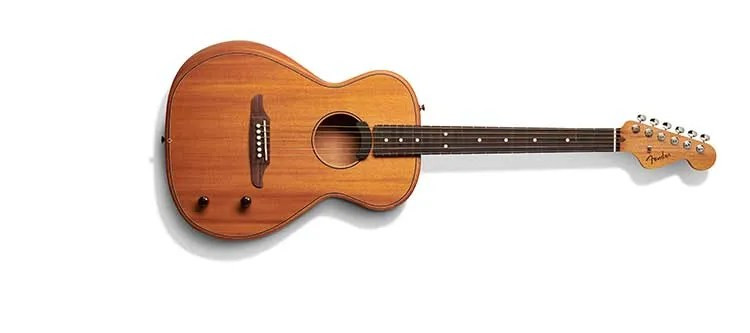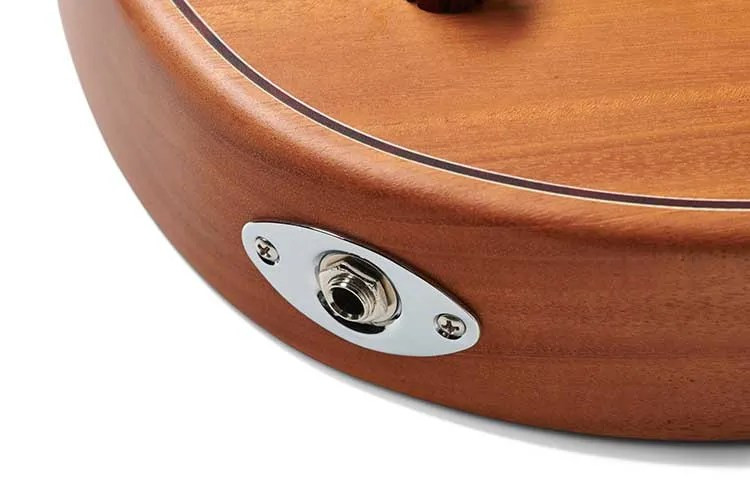When you’ve spent years immersed in the world of guitars, certain designs trigger immediate expectations. Picking up the Fender Highway Series Parlor acoustic-electric for the first time, preconceived notions about thin-body acoustics from an electric guitar giant inevitably surfaced. Would it truly bridge the gap, or lean too heavily into its electric heritage?
Many initial assumptions weren’t far off the mark. The neck, excluding the shorter scale, felt instantly familiar to a Telecaster player. The iconic Fender headstock, complete with six-in-line tuners, is unmistakable. The sleek contours and comfortable feel are clearly descendants of Fender’s electric guitar DNA, refined over decades since the Stratocaster’s inception.
However, the most significant surprise came with the sound. This compact, lightweight instrument defied expectations with its sonic fullness. The tone was surprisingly round, even verging on fat, delivering a low-end presence that belied its smaller size. It projected admirably for unplugged playing in intimate settings, proving its acoustic merits even before amplification.
Yet, the Highway Parlor, equipped with a custom Fishman Fluence pickup, is undeniably designed for the stage and studio. Testing it through a Phil Jones Nano Bass X4 amp, directly into a Universal Audio Apollo interface, and acoustically, revealed consistently impressive tone and remarkable versatility.
The Sonic Road of the Highway Parlor
The Highway Parlor is the more petite sibling in Fender’s thin-body acoustic-electric duo, offered in both all-mahogany and spruce-topped mahogany configurations. (This review focuses on the all-mahogany version). Unlike some past Fender acoustic ventures, the Highway doesn’t mimic an electric guitar in acoustic guise. Instead, it’s crafted for players desiring a more traditional acoustic shape, minus the bulk of a deep body. The Highway’s aesthetic is streamlined, almost aerodynamic, with inviting, sleek curves.
Much of the guitar’s innovation lies beneath the surface. The body is chambered and features a tapered floating X-bracing pattern. This sophisticated design yields a full sound profile, characterized by a rounder, less sharp high-end and a rich, rather than scooped, midrange.
 Fender Highway Series Parlor acoustic-electric guitar
Fender Highway Series Parlor acoustic-electric guitar
The instrument’s construction blends acoustic tradition with Fender electric elements. The neck utilizes a three-bolt system with tilt adjustment, reminiscent of 1980s Strats but executed with modern precision. The neck joint is exceptionally stable, free of dead spots, a testament to contemporary manufacturing.
Initially, the action was slightly high, but adjustments to both the truss rod and neck angle, easily made with the included Allen wrenches, quickly rectified this. While a manual wasn’t included with the test guitar, the adjustments were intuitive, taking mere minutes to achieve optimal playability.
The slim neck sports Fender’s comfortable “C” shape and a 12-inch fretboard radius. The nut width is a narrower 1.6875 inches, and the frets are tall and narrow, evoking a vintage Fender feel. The Highway is genuinely enjoyable to play. Despite the electric-like neck profile, fingerstyle acoustic playing felt natural and rewarding, with ample space for chord shapes and ringing open strings in arpeggiated patterns. Conversely, for students who find standard acoustic guitars challenging, the Highway’s neck offers enhanced accessibility.
Fender emphasizes the thin body’s comfort. While deep-bodied acoustics aren’t inherently uncomfortable for all, the Highway’s slender, contoured design is undeniably more ergonomic for many. For players who find larger guitars cumbersome, the Highway presents an easy-to-live-with alternative.
 Fender Highway Series Parlor back
Fender Highway Series Parlor back
Innovative Electronics
A cornerstone of the Highway’s design is the active Fluence pickup system. Visually and sonically distinct, the transducer is mounted at the soundhole’s top, its crescent shape mirroring the soundhole’s curve. The black pickup aesthetically complements the mahogany’s café au lait finish, appearing organically integrated. The guitar’s back panel houses a 9-volt battery compartment and an electronics service panel.
Two controls, volume and contour, are located below the bridge’s right side. The contour control is unlike typical tone knobs, cycling through a range of sonic profiles. At its maximum setting, the tone is richer and jazzier; rolled off, it becomes brighter and more acoustic-like, with a spectrum of tones in between.
Through the Phil Jones Nano Bass amp, the Highway exhibited a deep, rich sound. In typical review practice, allowing the instrument to guide the playing experience, the Highway inspired fingerstyle melodies on the lower strings. Attack control was effortless, yielding a clear, powerful tone. Slight treble adjustments at the amp enhanced the higher strings’ articulation, but the amplified string-to-string balance was notably impressive. The Fluence pickup avoids the piezo “quack,” while not sacrificing clarity.
Directly plugged into the Apollo interface and monitored with headphones, the contour control’s function became clearer. It primarily affects the midrange and low-mid frequencies, leaving the high-end largely untouched. The maximum setting boosts low-end punch, while rolling it off tightens the bass. This midrange shaping capability proves invaluable for tailoring the sound for various amplification systems, particularly house PA setups.
 Fender Highway Series Parlor output jack
Fender Highway Series Parlor output jack
Hitting the Right Notes with the Highway
Fender envisions the Highway as a compelling alternative to traditional acoustic guitars, retaining a flattop’s essence but tailored for electric players. The fast neck and slim body squarely hit this target.
But will it resonate with traditional acoustic players? For those proficient on dreadnoughts or nylon-strings, the neck profile might not be revolutionary. However, the Highway’s tonal range and resonant body create a unique sonic space, distinct from both standard electric and traditional acoustic guitars. It emerges as a potent option for looping or effects-driven acoustic music, where acoustic tone is desired, but electric-like control is paramount.
This article is inspired by and expands upon an article that originally appeared in the March/April 2024 issue of Acoustic Guitar magazine.
